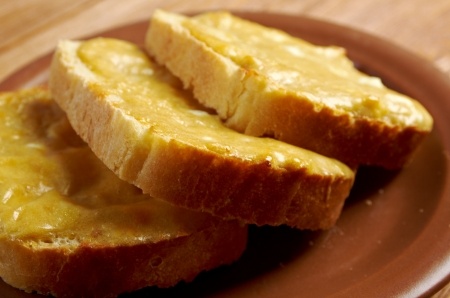
Take a trip to any café or restaurant for lunch and it’s likely you will come across Welsh Rarebit. This is the universally recognised toasted cheese dish which has probably no relation to eating furry creatures caught in the cabbage patch. It seems to belong to earlier times such as the 60’s when staples only were available and provided a healthy vegetarian dish full of carbohydrate and protein.
Welsh Rarebit is roughly defined as a piece of toasted bread with melted cheese smothered and dribbled over it. What makes it so special is the mustard and other spices, and beer which also forms part of the unctuous savoury sauce. It ought to be served with pickles, small amounts of vegetables, apple slices or some other condiment such as chili, paprika or cayenne pepper. The latter is a modern affectation which peps up the dish immeasurably.
We might consider it to be more accurately called Welsh Rabbit although both names have been in use since the mid-eighteenth century but there is little to establish its true origin. The Oxford English Dictionary records Welsh Rarebit or Rabbit back to 1725 but 60 years before, it was called rarebit.
It may be that the English looked down upon the Welsh which is not surprising given the warlike history between the two nations from the Norman Conquest to Edward I’s placing of a number of castles around the coast to keep Wales under control. The reference to Rabbit hints at English condescension because the Welsh were unable to afford such meat and the landlords banned the catching of rabbits. Rabbit was also a favoured food of the Normans and although a number would have escaped over the centuries, they were confined to managed warrens. It might just be a culinary play on words mind you. The other feature is the use of the word Welsh which was meant by the English to be ‘foreign’.
In the Rhondda Valley and around Ebbw Vale, Welsh Rarebit was a very common dish which provided plenty of protein because cheese, egg and milk were all used. Onion, chive but not garlic were added, beaten into the sauce mix.
The ‘rarebit’ part became common currency in about 1860 but didn’t enter parlance until 1910. To give a measure of the confusion, the lexicographer H.W. Fowler emphatically believed that “Welsh Rabbit is amusing and right. Welsh Rarebit is stupid and wrong” in his 1926 edition “A Dictionary of Modern English Usage”.
It also appears good enough to be referenced in novels such as Kevin Sampson’s ‘Awaydays’ from 2012:-
“I honestly haven’t really thought about him, except on Tuesday afternoon, sitting in Beatties’ café eating their fine Welsh rarebit, I started dwelling once again on all the hints he’s been dropping.”
The recipe is mainly the following:-
The Sauce Ingredients
- 8 oz. grated, strong Cheddar or Caerphilly cheese
- 1 tablespoon butter
- 2 teaspoons Worcestershire sauce
- 1teaspoon mustard
- 2 teaspoons plain flour
- 4 tablespoons beer or milk
- Freshly ground pepper (black preferred to white)
Preparation:
- All the dry ingredients save the pepper are mixed together in a saucepan which is then heated. The cheese melts to form the sauce to which is added the milk and beer with continuous stirring. The pan must not be allowed to get too hot or the sauce burns. Additions of liquid need to be carefully monitored so the sauce does not become runny but a paste should be created with regular stirring. Simply add flour and cheese to recover any sauce that is too runny.
- Grill a slice of bread on one side only! Turn the slices over and spread the cheese mixture on the untoasted side. Sprinkle with pepper or chilli and place under a medium grill until the sauce begins to bubble. The lowest heat feasible is advised so the sauce doesn’t burn and evenly coats the toast.
- In some instances the hot cheese sauce is served in a chafing dish to be spooned over the toast or for the pieces to be dipped in the sauce ‘a la fondue’.
The Tudor Kitchen written by Terry Breverton in 2015 describes a method of making national variants of the dish known as ‘Irish, Scotch, Welsh Rabbit and English Rabbit’ which had been described by the chef Hannah Glasse in her cookbook of 1747 ‘The Art Of Cookery’.
“To make a Scotch rabbit, toast the bread very nicely on both sides, butter it, cut a slice of cheese about as big as the bread, toast it on both sides, and lay it on the bread.
To make a Welch rabbit, toast the bread on both sides, then toast the cheese on one side, lay it on the toast, and with a hot iron brown the other side. You may rub it over with mustard.
To make an English rabbit, toast the bread brown on both sides, lay it in a plate before the fire, pour a glass of red wine over it, and let it soak the wine up. Then cut some cheese very thin and lay it very thick over the bread, put it in a tin oven before the fire, and it will be toasted and browned presently. Serve it away hot.
Or do it thus. Toast the bread and soak it in the wine, set it before the fire, rub butter over the bottom of a plate, lay the cheese on, pour in two or three spoonfuls of white wine, cover it with another plate, set it over a chafing-dish of hot coals for two or three minutes, then stir it till it is done and well mixed. You may stir in a little mustard; when it is enough lay it on the bread, just brown it with a hot shovel.”
When you add slices of tomato to the cheese on toast savoury, it becomes an Irish Rarebit ! If you are interested in another great Welsh product, take a look at the Glamorgan Sausage.
References
Glasse, Hannah. (ca. 1747) The Art of Cookery made Plain and Easy, …by a Lady (Posthumous edition, L. Wangford, London, c. 1770), p. 146
Sampson, Kevin. (2012) Awaydays. Random House ISBN 1448137608 p. 153
N.B. This post may contain links to various affiliate marketing partners. Please read our affiliate disclosure.

Leave a Reply